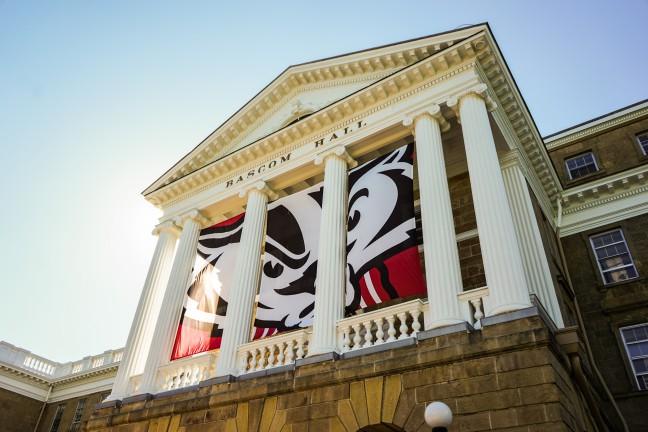Feb. 17, the University of Wisconsin Office of the Chancellor announced a concerning rise in cases among off-campus students, with efforts to ramp up testing using the new saliva-based method which had its own rocky introduction earlier this semester. This spring also marks the second full COVID-adjusted semester, with 82% of classes online compared to the fall semester’s 64%.
Considering UW’s ineptitude last semester which resulted in the quarantine of two dorms and a halt to on-campus student activity for two weeks, it’s unsurprising there’s already a rise in cases when half of this campus operates under unproven measures to mitigate viral spread — such as excessively wiping down classroom and library desks — while the other half exists as though there is no pandemic at all.
It’s apparent the latter outlook is most closely represented among leading UW administrators, with interim UW System President Tommy Thompson planning for 75% of classes in person next fall and no capacity limits at Camp Randall for the 2021 football season.
As for Camp Randall, virus mitigation means introducing an electronic ticketing system to prevent passing items back and forth, as well as stadium upgrades to limit common touchpoints, according to Deputy Athletic Director Chris McIntosh. It seems the 80,321 person stadium capacity is not the primary concern here, because as long as students keep their hands to themselves, it doesn’t matter everyone is breathing in tight proximity to one another — as students remember fondly from previous seasons.
Though McIntosh told reporters Badgers would change their approach in concert with coronavirus restrictions, it reads as exceptionally tone-deaf to announce a “normal” football season, not only after the failure to prevent an outbreak among players this past fall, but also given how poorly UW is currently able to manage the pandemic unfolding around them. It’s unwise to plan for a return to normal operations in any capacity when current operations are apparently not as effective as hoped, evidenced by the recent rise in cases.
Understanding COVID-19 long haulers essential to documenting true campus outbreak
Of course, UW Athletics is a distinct unit from academic operations, but this same blind optimism and corresponding planning efforts are seen in Thompson’s directive to UW chancellors for the majority of classes to be held in person come fall. In a virtual Q&A session, Thompson told reporters UW campuses have been “so safe” recently and “With testing, with vaccinations, with having our classes open, our dorms open, hopefully we’ll be playing sports, having a good time once again.”
This hopeful sentiment is also reflected by UW Vice Provost of Instructional Continuity and Academic Affairs Steven Cramer, who sent an email Feb. 11 stating UW was preparing for a primarily in-person fall semester, under the expectation those who wish to receive a vaccine prior to the start of classes will have been able to do so.
As a result, course enrollment will start in late March with classroom locations assigned later in the summer, which sounds awfully similar to course enrollment last spring during which students enrolled in entirely face-to-face classes only to find their entire schedules changed to remote delivery before the semester began.
Once released, COVID vaccine must become mandatory for all UW students
Additionally, while we might expect by next fall all students will be able to receive a COVID-19 vaccine, currently just under 6% of Wisconsin residents have received both doses of the vaccine, while just under 16% of Dane County residents have received at least one dose. Vaccine access is still highly limited, with the only non-restricted age group given access to the vaccine being those over age 65.
It’s no secret vaccine rollout nationwide and in Wisconsin has been slower than hoped for, but this also means students and UW administrators alike should not assume the undergraduate population will be fully vaccinated come fall. In effect, UW’s plans for next semester should reflect what is actually going on — not pipe dreams for a return to normalcy.
Fostering excitement and optimism among the student body for the day we can all return to packed lecture halls and Camp Randall student sections is not the issue here — it’s the actual planning reflecting this instead of considering it as a Plan B. Administrators should be emphasizing in-person instruction and a football season with public spectators are contingency plans, not the default.
Students should not bear responsibility to monitor others following Smart Restart failures
Instead, the exact opposite is going on.
“If we’re going to spend the time to plan for something, let’s plan for bringing a ruckus back into Camp Randall and bringing our fan base back,” McIntosh said when discussing football’s return in the fall.
With this outlook, we will surely have a repeat of this past fall in which the pandemic’s swift impact on campus took administrators by surprise. Managing student expectations through accurate and ultimately effective planning will better support undergraduates in the long run, instead of sowing seeds of hope amid false promises which will undoubtedly not be held up in the near future.
Anne Isman ([email protected]) is a sophomore majoring in economics and international studies.














